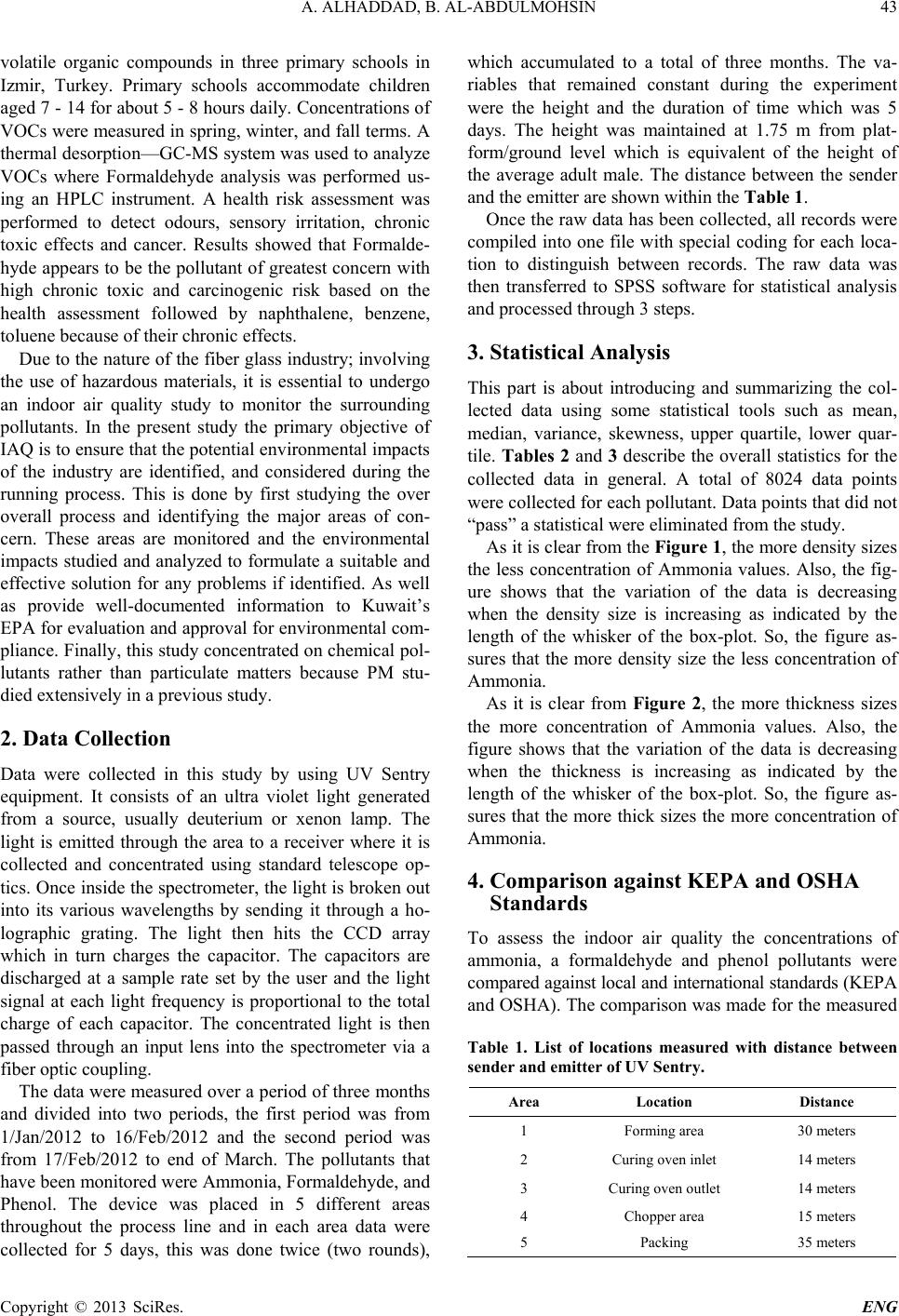
A. ALHADDAD, B. AL-ABDULMOHSIN
Copyright © 2013 SciRes. ENG
volatile organic compounds in three primary schools in
Izmi r, Turkey. Primary schools accommodate children
aged 7 - 14 for about 5 - 8 hours daily. Concentrations of
VOCs were measured in spring, winter, and fall terms. A
thermal desorption—GC-MS system was used to analyze
VOCs where Formaldehyde analysis was performed us-
ing an HPLC instrument. A health risk assessment was
performed to detect odours, sensory irritation, chronic
toxic effects and cancer. Results showed that Formalde-
hyde appears to be the pollutant of greatest concern with
high chronic toxic and carcinogenic risk based on the
health assessment followed by naphthalene, benzene,
toluene because of their chronic effects.
Due to the nature of the fiber glass industry; involving
the use of hazardous materials, it is essential to undergo
an indoor air quality study to monitor the surrounding
pollutants. In the present study the primary objective of
IAQ is to ensure that the potential env ironmental impacts
of the industry are identified, and considered during the
running process. This is done by first studying the over
overall process and identifying the major areas of con-
cern. These areas are monitored and the environmental
impacts studied and analyzed to formulate a suitable and
effective solution for any problems if identified. As well
as provide well-documented information to Kuwait’s
EPA for evaluation and approval for environmental com-
pliance. Finally, this study concentrated on chemical pol-
lutants rather than particulate matters because PM stu-
died extensively in a previous study.
2. Data Collection
Data were collected in this study by using UV Sentry
equipment. It consists of an ultra violet light generated
from a source, usually deuterium or xenon lamp. The
light is emitted through the area to a receiver where it is
collected and concentrated using standard telescope op-
tics. Once inside the spectrometer, the light is broken out
into its various wavelengths by sending it through a ho-
lographic grating. The light then hits the CCD array
which in turn charges the capacitor. The capacitors are
discharged at a sample rate set by the user and the light
signal at each light frequency is proportional to the total
charge of each capacitor. The concentrated light is then
passed through an input lens into the spectrometer via a
fiber optic coupling.
The data were measured over a period of three months
and divided into two periods, the first period was from
1/Jan/2012 to 16/Feb/2012 and the second period was
from 17/Feb/2012 to end of March. The pollutants that
have been monitored were Ammonia, Formaldehyde, and
Phenol. The device was placed in 5 different areas
throughout the process line and in each area data were
collected for 5 days, this was done twice (two rounds),
which accumulated to a total of three months. The va-
riables that remained constant during the experiment
were the height and the duration of time which was 5
days. The height was maintained at 1.75 m from plat-
form/ground level which is equivalent of the height of
the average adult male. The distance between the sender
and the emitter are shown within the Table 1.
Once the raw data has b een collected, all records were
compiled into one file with special coding for each loca-
tion to distinguish between records. The raw data was
then transferred to SPSS software for statistical analysis
and proce s sed throu gh 3 steps .
3. Statistical Analysis
This part is about introducing and summarizing the col-
lected data using some statistical tools such as mean,
median, variance, skewness, upper quartile, lower quar-
tile. Tables 2 and 3 describe the overall statistics for the
collected data in general. A total of 8024 data points
were collected for each pollu tant. Data p oints that d id no t
“pass” a statistical were eliminated from the study.
As it is clear from the Figure 1, the more density sizes
the less concentration of Ammonia values. Also, the fig-
ure shows that the variation of the data is decreasing
when the density size is increasing as indicated by the
length of the whisker of the box-plot. So, the figure as-
sures that the more density size the less concentration of
Ammonia.
As it is clear from Figure 2, the more thickness sizes
the more concentration of Ammonia values. Also, the
figure shows that the variation of the data is decreasing
when the thickness is increasing as indicated by the
length of the whisker of the box-plot. So, the figure as-
sures that the more thick sizes the more concentration of
Ammonia.
4. Comparison against KEPA and OSHA
Standards
To assess the indoor air quality the concentrations of
ammoni a, a formaldehyde and phenol pollutants were
compared against local and international standards (KEPA
and OSHA). The comparison was made for the measured
Table 1. List of locations measured with distance between
sender and emitter of UV Sentry.
Area Location Distance
1 Forming area 30 meters
2 Curing oven inlet 14 meters
3 Curing oven outlet 14 meters
4 Chopper area 15 meters
5 Packing 35 meters